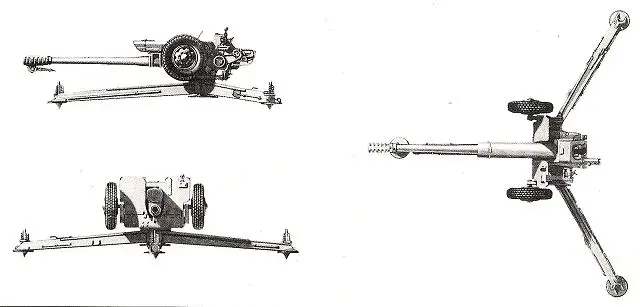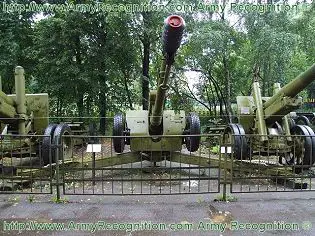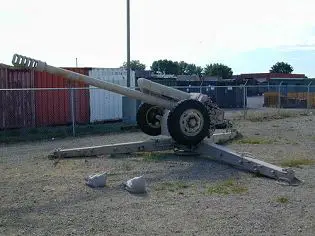- Army
- Air Defense Systems
- Anti-tank systems and vehicles
- Armored Vehicles
- Armoured personnel carriers
- Artillery Vehicles and Weapons
- Command Post
- Communication Vehicles and Systems
- Electronic Warfare
- Engineer | Maintenance Vehicles
- Infantry Fighting Vehicles
- Main Battle Tanks
- Missiles
- Tactical and Logistic Vehicles
- Radars
- Unmanned Systems
- Weapons
- Navy
- Air
D-30 2A18
| Version française |
D-30 2A18
122mm towed howitzer - Russia

Description
The D-30, Russian designation 2A18, is a Russian-made 122 mm towed howitzer that first entered service in the 1960s with the Russian army. The D-30 is designed to defeat unsheltered and covered manpower, weapons and military equipment of the enemy at the forward edge of the battle area and to the regiment's mission depth. The D-30 has been widely exported and used in wars around the world, notably in the Middle East, and particularly in the Iran-Iraq War.
D-30 2A18 122mm howitzer variants:
Late production models of the D-30 are designated the D-30M and have a number of modifications including a new double-baffle muzzle brake, a new central baseplate that is square rather than round, and a towing lunette assembly. It also features modifications to its cradle, carriage and recoil system. As it is ballistically the same as the earlier D-30 it has the same range and capabilities.
Technical Data
| Armament |
|
The D-30 uses the 2A18 gun which is also used by the Russian 2S1 tracked self-propelled howitzer. The maximum rate of fire of the D-30 is 6-8 rounds per minute and about 75 rounds per hour. The D-30 fires FRAG-HE and HEAT-FS variable-charge, case-type, separate-loading ammunition. Using standard HE-Frag shells, the D-30 has a maximum firing range of 15.4 km. China has developed a rocket-assisted round that is capable to reach a maximum firing range of 21.9 km. There are at least two chemical projectiles for the D-30, with the CW agent is dispersed by the explosion of a TNT bursting charge. The Sarin projectile weighs 22.2 kg with 1.3 kg of Sarin agent. The 122 mm Lewisite projectile weight is 23.1 kg with 3.3 kg of viscous Lewisite agent.
|
| Design |
|
The 122 mm howitzer is mounted on a three-trail carriage with an all-around traverse. To raise the wheels clear of the ground, a hydraulic jack with a baseplate is used. The D-30 howitzer is loaded manually.
|
| Mobility |
| A pair of large tires is suspended on a single trailing arm; the maximum towing speed is 60 km/h on the road. On road position, the D-30 howitzer can be towed by a military truck or tracked vehicle. In firing position, the crew of eight unhitches the gun, lowers the central firing jack, raises the wheels high enough to clear the trail legs, and spreads the two outer trails 120° on each side. The revolving mount permits 360° traverse and is equipped for high and low angles of fire, making it fully suitable for antitank defense. Elevation and traverse is manual with the former being from -7° to +70º. |
| Accessories |
| Fire-control instruments include a Type PG-1M panoramic sight, Type OP4M-45 telescopic sight, and a Type K-1 collimator. The D-30 can also be equipped with IR or passive night vision sights for direct fire. |
Specifications
| Armament | Ammunition |
| One 122m 2A18 gun | FRAG-HE, HEAT-FS, Chemical |
| Country users | Weight |
| 63 countries in the world from Asia, East Europe, Middle East and Africa. | 3,300 kg |
| Designer Country | Rate of fire |
| Russia | 6 - 8 rds/min |
| Accessories | Range |
| Panoramic sight, IR or passive night vision | 4 - 15.3 km |
| Crew | Traverse - elevation |
| 6 | Traverse: 360°; Elevation +70°/-7° |
| Mobility | Dimensions (traveling) |
| 80 km/h maximum towed speed by truck | Length: 5.4 m; Width: 2.2 m; Height: 1.8 m |
Details View
 |
|
 |
 |
 |
 |
Pictures - Video



























